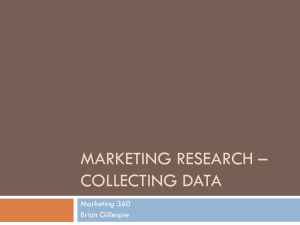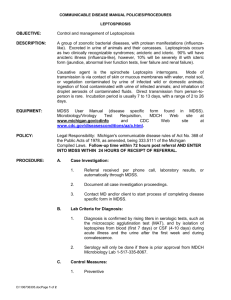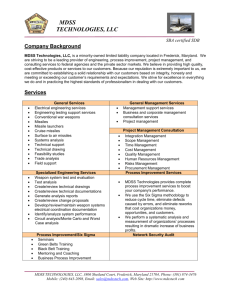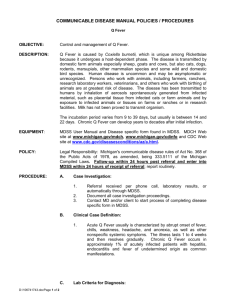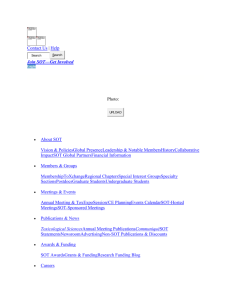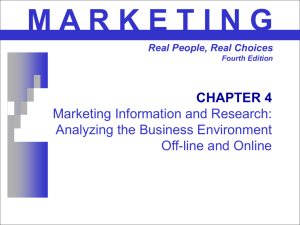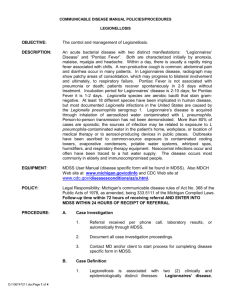President’s Message Fall 2010
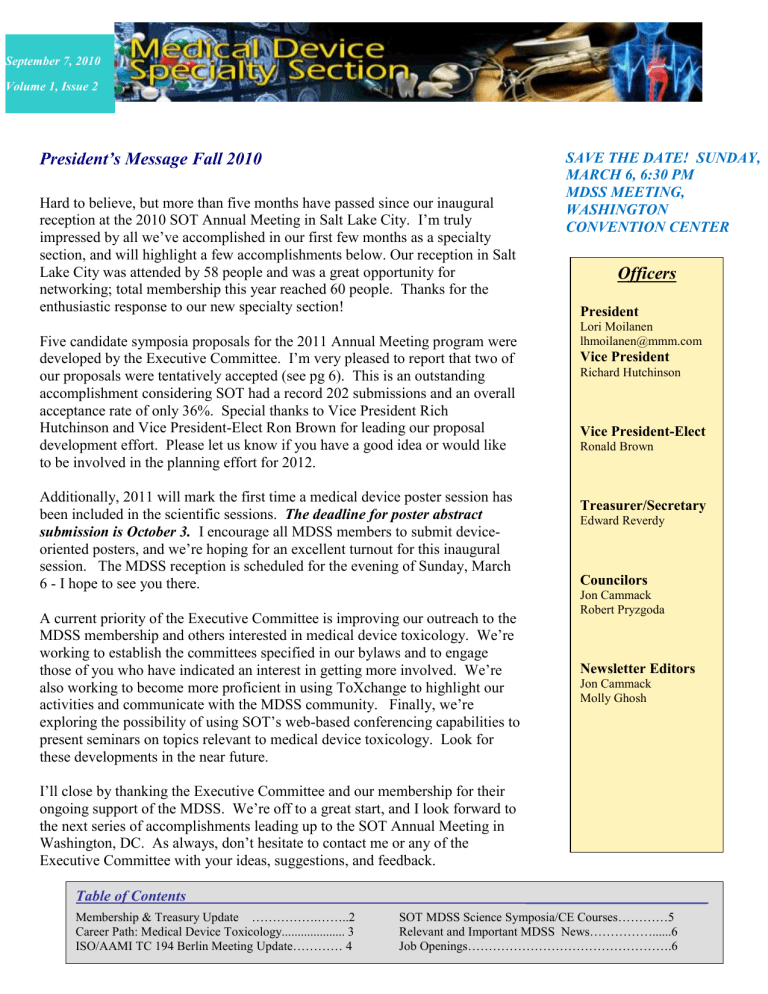
September 7, 2010
Volume 1, Issue 2
President’s Message Fall 2010
Hard to believe, but more than five months have passed since our inaugural reception at the 2010 SOT Annual Meeting in Salt Lake City. I’m truly impressed by all we’ve accomplished in our first few months as a specialty section, and will highlight a few accomplishments below. Our reception in Salt
Lake City was attended by 58 people and was a great opportunity for networking; total membership this year reached 60 people. Thanks for the enthusiastic response to our new specialty section!
SAVE THE DATE! SUNDAY,
MARCH 6, 6:30 PM
MDSS MEETING,
WASHINGTON
CONVENTION CENTER
Officers
President
Lori Moilanen lhmoilanen@mmm.com Five candidate symposia proposals for the 2011 Annual Meeting program were developed by the Executive Committee. I’m very pleased to report that two of our proposals were tentatively accepted (see pg 6). This is an outstanding accomplishment considering SOT had a record 202 submissions and an overall acceptance rate of only 36%. Special thanks to Vice President Rich
Hutchinson and Vice President-Elect Ron Brown for leading our proposal development effort. Please let us know if you have a good idea or would like to be involved in the planning effort for 2012.
Additionally, 2011 will mark the first time a medical device poster session has been included in the scientific sessions. submission is October 3.
The deadline for poster abstract
I encourage all MDSS members to submit deviceoriented posters, and we’re hoping for an excellent turnout for this inaugural session. The MDSS reception is scheduled for the evening of Sunday, March
6 - I hope to see you there.
A current priority of the Executive Committee is improving our outreach to the
MDSS membership and others interested in medical device toxicology. We’re working to establish the committees specified in our bylaws and to engage those of you who have indicated an interest in getting more involved. We’re also working to become more proficient in using ToXchange to highlight our activities and communicate with the MDSS community. Finally, we’re exploring the possibility of using SOT’s web-based conferencing capabilities to present seminars on topics relevant to medical device toxicology. Look for these developments in the near future.
I’ll close by thanking the Executive Committee and our membership for their ongoing support of the MDSS. We’re off to a great start, and I look forward to the next series of accomplishments leading up to the SOT Annual Meeting in
Vice President
Richard Hutchinson
Vice President-Elect
Ronald Brown
Treasurer/Secretary
Edward Reverdy
Councilors
Jon Cammack
Robert Pryzgoda
Newsletter Editors
Jon Cammack
Molly Ghosh
Washington, DC. As always, don’t hesitate to contact me or any of the
Executive Committee with your ideas, suggestions, and feedback.
Table of Contents
Membership & Treasury Update …………….……..2
Career Path: Medical Device Toxicology.................... 3
ISO/AAMI TC 194 Berlin Meeting Update………… 4
________________________
SOT MDSS Science Symposia/CE Courses…………5
Relevant and Important MDSS News……………......6
Job Openings………………………………………….6
Membership & Treasury Update
Medical devices range from sutures and bandages to
imaging technologies.
Consider sponsoring the MDSS and further the efforts of science and education for these life- sustaining and life-saving products.
Tell a colleague about the MDSS – the process for joining is simple!
The MDSS started our inaugural year in 2010 with 52 registered members. Many of them were present in Salt
Lake City at the annual meeting of the SOT, and current membership stands at 60. Several new members have come forward and offered their time and ideas for the different committees as well as for symposia and workshops to be presented at the 50 th
meeting of the
SOT in Washington, DC in March 2011.
Budget and financial information - as indicated in the previous MDSS Newsletter, several entities and companies have provided generous donations (totaling
$8500).
Additional funds have been generated as follows:
Income
Starting donations - $8500.00
Dues 885.00
Registration 539.00
Interest
Total Income
Expenses
520.00
10,443.00
SOT Reception <2032.00>
SOT contribution 2500.00
____________________________
Final Balance $10,911.00
June 2010
As is evident, we are in a financially sound position for a new specialty section, and will continue to manage finances and expenses judiciously.
Page 2
Dues Reminder – Please Keep Your Membership Current!
Career Path: Medical Device Toxicology
Medical devices are a unique category of medical products and comprise highly dissimilar products – as such, device toxicologists are confronted with a variety of materials and body contact scenarios. The regulatory climate is evolving to a risk-management approach where biological evaluation by knowledgeable experts is mandated. Also, increased media attention and public awareness of complex and sometimes misrepresented information has resulted in device toxicologists frequently addressing public concerns about potential health effects of device constituents such as dental amalgams or bisphenol A (BPA).
Devices and drugs may be handled by the same regulatory bodies, but they act via different mechanisms which dictate different approaches to regulation, testing, and risk assessment. In contrast to drugs, most devices work through physical rather than chemical action; the materials used in devices are chosen to be of low biological reactivity; devices frequently contact their target tissue; and device safety can rarely be assessed by altering dose-response or dose frequency. Device materials often have a history of use in humans and, unlike drugs, regulatory agencies do not automatically require testing for devices. Device assessment starts with a review of existing information on the component materials and their chemical constituents. Safety studies may be warranted, along with use of published literature that extends beyond toxicology data to include material physical/chemical properties and historic human exposure data.
The information obtained through literature review may demonstrate device biocompatibility without the need for new safety tests. When device testing is necessary, options for dose-response studies are limited, so devices are usually tested under “real-case” rather than “worst case” conditions. When the test system requires liquid dose forms, solvent extracts of the device are used. Finally, a device’s local effects are as important as its systemic effects.
The different assessments strategies also result in different project timelines for drugs and devices. Even allowing for biocompatibility tests, a device safety assessment typically requires a fraction of the time needed for a pharmaceutical testing program. New devices can be approved (or halted) within months, compared with the decade or more typically required for new drugs/chemical entities. Toxicologists who desire closure will find that device work can provide great satisfaction!
Another exciting option to consider for toxicologists with interests in devices is the Food and Drug Administration (FDA). FDA is responsible for protecting public health by ensuring the safety and effectiveness of all medical devices. Toxicologists at FDA play a critical role in the safety assessment of medical devices – a reviewing toxicologist’s primary role is to serve as the scientific and regulatory expert responsible for assessing the adequacy of scientific data used to support the safe use of medical devices in humans. Toxicologists who are interested in public service will undoubtedly find a satisfying career at FDA by using their scientific knowledge to safeguard public health.
SAVE THE DATE! SUNDAY, MARCH 6, 6:30 PM, MDSS MEETING
Submit your abstract now for the inaugural
Medical Device
Poster Session.
Check the “Medical
Device” box and include “medical device” as a key word to be considered for this session. The deadline for abstract submission is October 3, 2010.
!
.
Page
2
ISO10993 standards are available through country accredited organizations. In the
U.S., it’s AAMI.
Visit our Web site for more information on the MDSS: http://www.toxicology.org/
ISOT/SS/mdss/Index.asp
Page 2
ISO/AAMI TC 194 Berlin Meeting Update
The German member body and Secretariat of ISO/TC 194, DIN, hosted the ISO/TC 194 "Biological evaluation of medical devices" and its working groups at the DIN headquarters in Berlin, Germany, from 28 June to 2 July 2010. During the week, a number of the TC
194 working groups (WG’s) met, and the final day of the meeting,
Friday, 2 July 2010 comprised the 22nd meeting of entire ISO/TC
194.
Highlights of the meeting are presented below, and an additional special feature of the meeting was an ad hoc session on the safety of nanomaterials in medical devices. The current 10993 standards are guidelines and guidance on how potential risks to patients can be minimized during medical device use following a risk management approach. However, special considerations that may arise from the use of nanomaterials are not currently specifically addressed in the standards. To stimulate discussion and identify potential actions, three invited lectures, followed by a TC 194 open exchange, occurred on Monday, 28 June from 4:30-8:00 p.m. The three speakers were Dr. Steffi Friedrichs, Director General,
Nanotechnology Industries Association (NIA), Brussels;
Dr. Christoph Klein, Institute for Health and Consumer Protection
(IHCP), Nanotechnology, Ispra; and Robert E. Geertsma, RIVM -
National Institute for Public Health and the Environment,
Bilthoven. A primary outcome of the session was formation of an assessment group within WG 15 (a working group whose focus is longer-term strategic initiatives) to determine if the safety of nanomaterials in devices necessitates a separate WG and/or standard(s).
Other highlights of the Berlin TC 194 meeting include:
Continued revision and resolution of comments on a significantly revised standard on blood interactions (Part 4).
Acceptance of the Threshold for Toxicological Concern
(TTC) concept in medical device applications as a new element in the current ISO 10993-17 standard; appropriate as Part 17 focuses on risk assessment of leachables from devices.
Continued revision and acceptance of comments for moving the DEHP tolerable intake work product forward.
Formation of a new task force in WG 15 to focus on emerging science and technologies in assessing safety of devices.
Election of Dr. Victoria Hitchins (FDA) as Convener of WG
16 (Pyrogenicity)
SAVE THE DATE! SUNDAY, MARCH 6, 6:30 PM, MDSS MEETING
2011 MDSS Symposia and CE Courses
MEDICAL DEVICE SPECIALTY SECTION SUCCESSFUL IN
SCIENTIFIC SESSION APPROVAL
The MDSS received preliminary approval for a sunrise continuing education seminar on bio-absorbable polymers, and for an informational session on the use of the Threshold of Toxicological Concern for medical devices, both to be held at the 2011 SOT meeting in Washington, D.C. We’re excited that these two sessions were approved the very first year of our specialty section and thank all of the many people who helped generate the five proposals that were submitted to SOT in April.
The Sunrise CE course on “Safety and Application of Biodegradable Materials for Tissue Engineering” will be presented by John P. Fisher, PhD and chaired by
Ronald P. Brown. This CE course will discuss the incorporation of biodegradable materials as a fundamental component in tissue regeneration strategies. The presentation will introduce a number of natural and synthetic biodegradable materials that are commonly considered in regenerative medicine, as well as some recently developed novel materials. The techniques utilized to describe their physical properties and the relationship between physical properties and tissue response will be examined, and advanced techniques for material characterization and toxicological effects will be considered. Finally, the application of these biodegradable materials in tissue engineering strategies will be described.
The Informational Session on “Use of the TTC Concept for Medical Devices” will be chaired by Dr. Rich Hutchinson and co-chaired by Ronald P. Brown.
Presenters include: Mitch Cheeseman (US FDA: CFSAN), Jon Cammack, (ISIS
Services), Richard W. Hutchinson, (Johnson & Johnson: Ethicon) and Ron
Brown (US FDA: CDRH). The Threshold of Toxicological Concern (TTC) is a concept used to estimate safe exposure levels for chemicals for which toxicological data are not available. The seminar will begin with a discussion of the history of the TTC concept; the second seminar will describe how tolerable intake levels are set for medical device extractables; the third session will describe how the TTC concept can be used for extractable chemicals from medical devices for which structural information is known but the toxicological database is insufficient; the final seminar will describe validation of a software package in the context of extractable chemicals known to be relevant to medical devices.
We are also very happy to announce that the Program Committee has now merged with the Awards Committee and added three new members. We welcome Gregory Erexson from Baxter, Jeffrey White from Kimberly Clark, and
Joel Gorski from NAMSA and thank them for their service on this committee.
Consider nominating for a specialty section session.
Page 2
2011 MDSS Symposia and CE Courses – Program & Awards Committee
The Program and Awards Committee is asking for suggestions, nominations and volunteers from members of the specialty section. We would very much appreciate hearing of speakers who are relevant to medical device toxicology. If you are interested in nominating any individuals for presenting at a MDSS webinar, please contact Rich Hutchinson at (rhutchin@its.jnj.com).
Relevant and Important MDSS News
SOT has posted a position statement on Phthalates: http://www.toxicology.org/pr/ToxTopics/TT11_phthalate.pdf
FDA has developed two comprehensive assessments on the 510(k) premarket review process and the use of science in CDRH’s regulatory decision making: http://www.fda.gov/AboutFDA/CentersOffices/CDRH/CDRHReports/ucm220
272.htm
There will be a public workshop on Medical Devices and Nanotechnology:
Manufacturing, Characterization, and Biocompatibility Considerations on
September 23, 2010. http://edocket.access.gpo.gov/2010/pdf/2010-20837.pdf
Job Openings
*This is a new section for our newsletter. Any MDSS member is welcome to provide information on openings in relevant areas of device toxicology. We will also likely start posting on the MDSS website.
Page 6
SAVE THE DATE! SUNDAY, MARCH 6, 6:30 PM, MDSS MEETING
